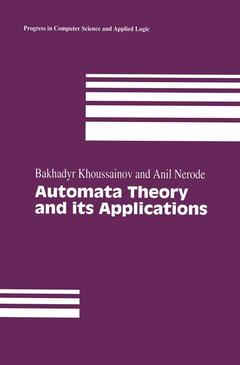Automata Theory and its Applications, 2001 Progress in Computer Science and Applied Logic Series, Vol. 21
Langue : Anglais
Auteurs : Khoussainov Bakhadyr, Nerode Anil

The theory of finite automata on finite stings, infinite strings, and trees has had a dis tinguished history. First, automata were introduced to represent idealized switching circuits augmented by unit delays. This was the period of Shannon, McCullouch and Pitts, and Howard Aiken, ending about 1950. Then in the 1950s there was the work of Kleene on representable events, of Myhill and Nerode on finite coset congruence relations on strings, of Rabin and Scott on power set automata. In the 1960s, there was the work of Btichi on automata on infinite strings and the second order theory of one successor, then Rabin's 1968 result on automata on infinite trees and the second order theory of two successors. The latter was a mystery until the introduction of forgetful determinacy games by Gurevich and Harrington in 1982. Each of these developments has successful and prospective applications in computer science. They should all be part of every computer scientist's toolbox. Suppose that we take a computer scientist's point of view. One can think of finite automata as the mathematical representation of programs that run us ing fixed finite resources. Then Btichi's SIS can be thought of as a theory of programs which run forever (like operating systems or banking systems) and are deterministic. Finally, Rabin's S2S is a theory of programs which run forever and are nondeterministic. Indeed many questions of verification can be decided in the decidable theories of these automata.
1. Basic Notions.- 1.1 Sets.- 1.2 Sequences and Tuples.- 1.3 Functions, Relations, Operations.- 1.4 Equivalence Relations.- 1.5 Linearly Ordered Sets.- 1.6 Partially Ordered Sets.- 1.7 Graphs.- 1.8 Induction.- 1.9 Trees and König’s Lemma.- 1.10 Countable and Uncountable Sets.- 1.11 Algorithms.- 2 Finite Automata.- 2.1 Two Examples.- 2.2 Finite Automata.- 2.3 Closure Properties.- 2.4 The Myhill—Nerode Theorem.- 2.5 The Kleene Theorem.- 2.6 Generalized Finite Automata.- 2.7 The Pumping Lemma and Decidability.- 2.8 Relations and Finite Automata.- 2.9 Finite Automata with Equations.- 2.10 Monadic Second Order Logic of Strings.- 3 Büchi Automata.- 3.1 Two Examples.- 3.2 Büchi Automata.- 3.3 The Büchi Theorem.- 3.4 Complementation for Büchi Automata.- 3.5 The Complementation Theorem.- 3.6 Determinism.- 3.7 Müller Automata.- 3.8 The McNaughton Theorem.- 3.9 Decidability.- 3.10 Büchi Automata and the Successor Function.- 3.11 An Application of the McNaughton Theorem.- 4 Games Played on Finite Graphs.- 4.1 Introduction.- 4.2 Finite Games.- 4.3 Infinite Games.- 4.4 Update Games and Update Networks.- 4.5 Solving Games.- 5 Rabin Automata.- 5.1 Rabin Automata.- 5.2 Special Automata.- 5.3 Game Automata.- 5.4 Equivalence of Rabin and Game Automata.- 5.5 Terminology: Arenas, Games, and Strategies.- 5.6 The Notion of Rank.- 5.7 Open Games.- 5.8 Congruence Relations.- 5.9 Sewing Theorem.- 5.10 Can Mr. (?) Visit C Infinitely Often?.- 5.11 The Determinacy Theorem.- 5.12 Complementation and Decidability.- 6 Applications of Rabin Automata.- 6.1 Structures and Types.- 6.2 The Monadic Second Order Language.- 6.3 Satisfiability and Theories.- 6.4 Isomorphisms.- 6.5 Definability in T and Decidability of S2S.- 6.6 The Structure with ? Successors.- 6.7 Applications to LinearlyOrdered Sets.- 6.8 Application to Unary Algebras.- 6.9 Applications to Cantor’s Discontinuum.- 6.10 Application to Boolean Algebras.
Date de parution : 11-2012
Ouvrage de 432 p.
15.5x23.5 cm
Date de parution : 06-2001
Ouvrage de 432 p.
15.5x23.5 cm
Thème d’Automata Theory and its Applications :
Mots-clés :
Automat; automata; complexity; finite automata; logic; modeling; verification
© 2024 LAVOISIER S.A.S.



